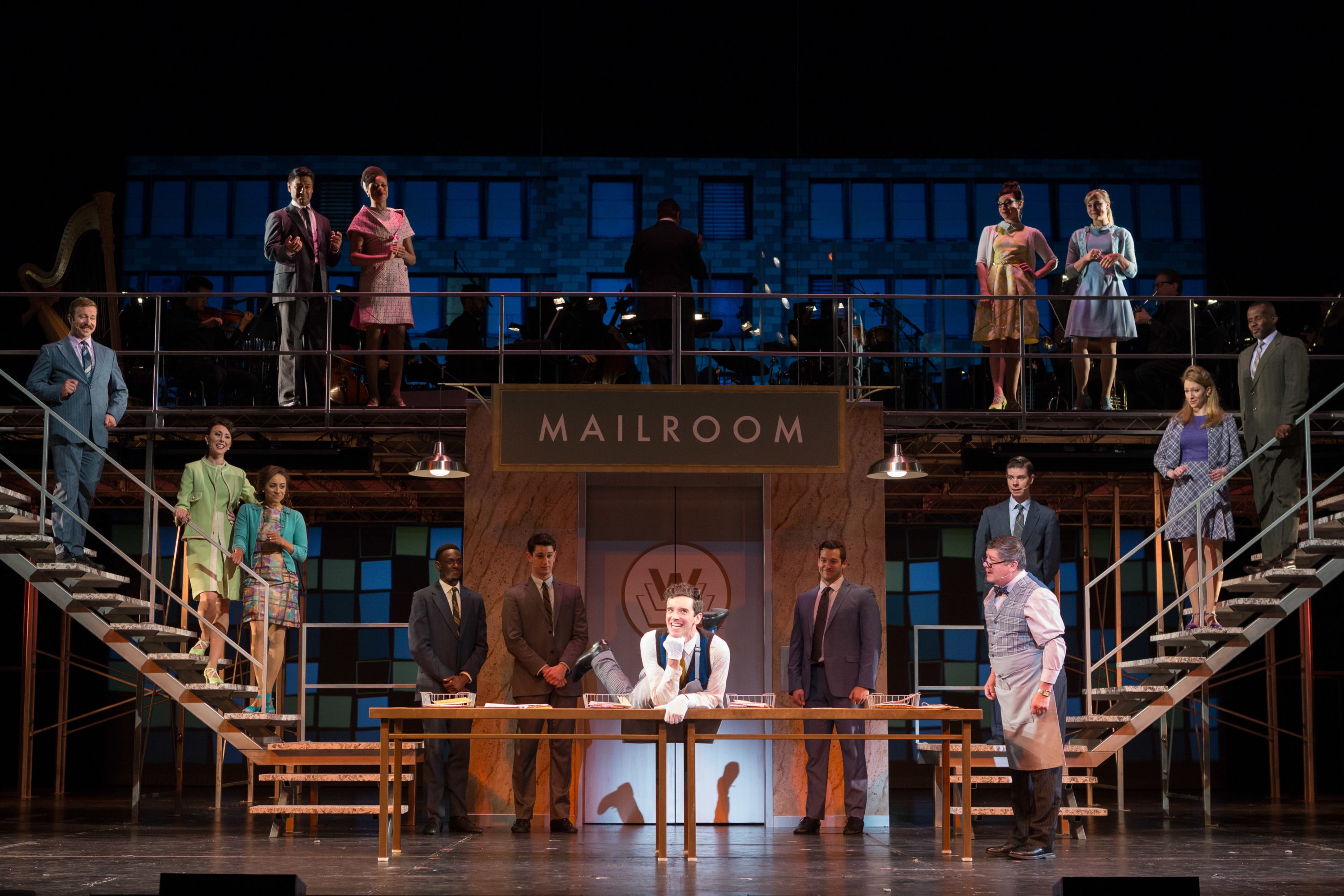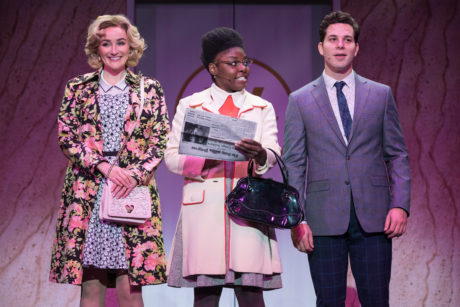The Kennedy Center advertises its Broadway Center Stage series as presenting shows in a “semi-staged concert format.” For Frank Loesser’s 1961 satire of mid-20th century New York corporate life, How to Succeed in Business Without Really Trying (book by Abe Burrows, Jack Weinstock, and Willie Gilbert), that claim is too modest. What the enthusiastic full house at the Eisenhower Theater saw Thursday night was a fully realized production of a classic show from the “Golden Age” of Broadway musicals. Every aspect of the show – acting, singing, dancing, costumes, set, lighting – was brilliantly executed.

Like The Pajama Game is an artifact of 1950s labor-management relations in small local manufacturing companies, How to Succeed is also a creature of the corporate world of that era. Shepherd Mead, who wrote the spoof self-help book of the same title that inspired the show, rose from the mail room to the executive suite of a Manhattan advertising agency between 1936 and the 1952 publication of his book.
Men advance in this world as long-term employees of a single company, ascending the bureaucratic “corporate ladder” to higher perches in well-entrenched hierarchies. Conformity was the key to one’s slow, gradual progress. “The Company Way,” led by corporate lifer Mr. Twimble (Michael McGrath), says it well. Women with ambition pursue men on the rise, their goal being an executive husband and a home in a posh suburb.
So how does a fellow disrupt the process and rise to the top quickly without enduring long years as a yes man? In the case of J. Pierrepont Finch (Skylar Astin), you mislead, lie, flatter, and set rivals up for failure, all the while playing office politics like a violin. Finch is a corporate exemplar of an old acting cliché: “Ninety percent of acting is sincerity, and if you can fake that, you’ve got it made.” (It’s not for nothing that the subtitle of Mead’s book was “The Dastard’s Guide to Fame and Fortune.”)
Astin gives us as smart, quick-thinking, adorably cute, ambitious, and devious a Finch as one could ask for. He moves fluidly and sings effortlessly, including that hymn to shallow self-regard, “I Believe in You,” which became the show’s best-known song. His energy propels the show.
Ambitious secretary Rosemary Pilkington (Betsy Wolf) sets her sights on Finch. Singing with a clear, supple soprano voice, Wolf articulates her dream of suburban wedded bliss in “Happy to Keep His Dinner Warm” early in the first act, and she is as determined to achieve her goal as Finch is to achieve his. Once she gets her man (and, this being a light comedy, of course, she will) and her home in New Rochelle, it is easy to imagine her in a few years recognizing herself in The Feminine Mystique or living the life of one of Sondheim’s “Ladies Who Lunch.”

It must be said that, through no fault of Astin and Wolf, the love subplot of the show never gains emotional traction. Loesser created some of the greatest Broadway love stories, like Sky and Sarah or Tony and Rosabella, but in a story focusing on realizing ambitions, deep feelings don’t have a chance to develop.
A key feature of mid-century corporate life was the secretary, that indispensible, lower-paid, female office helper and sometime object of illicit desires. The World Wide Wicket Company has stronger “hands-off” policies than most firms of its era. As “A Secretary is Not a Toy” explains, what nowadays would be called sexual harassment results in firing or a transfer to the Venezuela office.
Two of the secretaries deserve special mention. Joaquina Klukango is outstanding as Rosemary’s wing woman, Smitty, who has a Radar O’Reilly-like talent for anticipating her bosses’ needs. Nova Y. Patton’s Miss Jones, through most of the show simply the formidable executive secretary to CEO J.B. Bigley (John Michael Higgins), cuts loose with a spectacular jazz solo in “Brotherhood of Man.”
At the other end of the secretarial spectrum is Hedy LaRue, Bigley’s dim, sexy, mistress who compensates in curves for what she lacks in shorthand skills. Becki Newton does what she can with this stock role, especially at the moment when she manages to create a corporate disaster.

As Bigley, Higgins basks in the obeisance of his yes men, wears his loyalty to his college football team on his sleeve, takes comfort in knitting, and is vexed by the demands of LaRue and his smarmy, incompetent nephew, Bud Frump (Michael Urie).
Bigley is attracted by Finch’s smarts and is easily deceived by his wiles, above all by a ploy he doesn’t see coming near the end of the show. The physically flexible Urie takes the comically villainous Frump about as far over the top as the character can go, reveling in his schemes to advance himself at Finch’s expense.
The company’s complaint executives – played by Sean Bell, John Bolton, and Dwayne Clark, among others – all read as distinct individuals, who also contribute greatly to the ensemble scenes and numbers. How to Succeed is a strong ensemble show, and the choreography (Denis Jones) of numbers like “Coffee Break,” “Been a Long Day,” “Paris Original,” “The Pirate Dance,” and “Brotherhood of Man” – the latter brought down the house near the show’s conclusion — is lively, fun, and precise.
Scenic Designer Scott Pask places Todd Ellison’s large, excellent orchestra atop a high platform upstage, in front of which is a walkway used by the actors on occasion, accessed by stairways on either side, and backed by an often-changing rear projection of an office building façade. Chairs and tables glide smoothly on and off stage. “Semi-staged” or not, the metallic scaffold-style set does everything, visually and functionally, that a set needs to do.
Peter Kaczorowski’s complex and colorful lighting design is lovely to look at; when Finch or Frump has a bright idea, the actor has a brief freeze illuminated by a bright special. Amy Clark’s costume designs are equally effective, notably pastel polyester for most of the women, suits that moved well for the men, LaRue’s pirate outfit, the glittery gold dresses for the dancers in the TV show scene, the red dresses in “Paris Original,” and Bigley’s egregious golf costume.
While lacking the memorable songs of his Guys and Dolls or The Most Happy Fella, Loesser’s jaunty score is well-tailored to the mood of How to Succeed, much to the audience’s delight. The show was a hit from the beginning, garnering several Tonys and a Pulitzer as well as a four-year first run and a movie version. The Kennedy Center production makes it easy to see why.
Running Time: Two hours and 45 minutes, including one intermission.
How to Succeed in Business Without Really Trying is playing through June 10, 2018, in the Eisenhower Theater at the Kennedy Center – 2700 F Street, NW, in Washington, DC. For tickets, call the box office at 202-467-4600, or purchase them online.





The excellent large orchestra mentioned favorably in this review was the Kennedy Center Opera House Orchestra, a versatile organization, that only the week before admirably supported the Cuban Ballet in the Opera House.